The AMD Radeon R9 290X Review
by Ryan Smith on October 24, 2013 12:01 AM EST- Posted in
- GPUs
- AMD
- Radeon
- Hawaii
- Radeon 200
GRID 2
The final game in our benchmark suite is also our racing entry, Codemasters’ GRID 2. Codemasters continues to set the bar for graphical fidelity in racing games, and with GRID 2 they’ve gone back to racing on the pavement, bringing to life cities and highways alike. Based on their in-house EGO engine, GRID 2 includes a DirectCompute based advanced lighting system in its highest quality settings, which incurs a significant performance penalty but does a good job of emulating more realistic lighting within the game world.
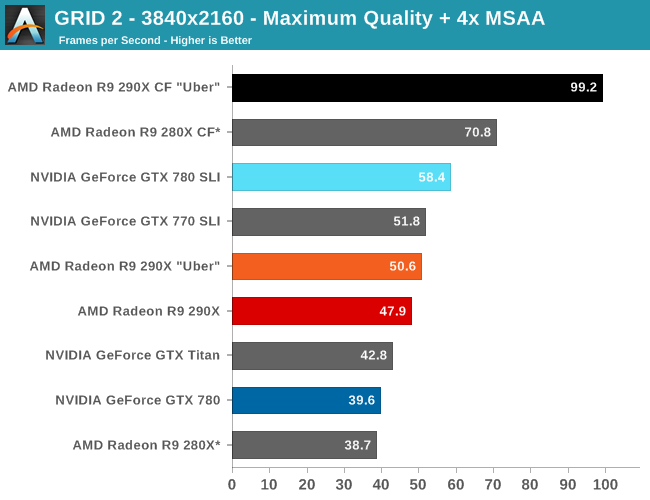
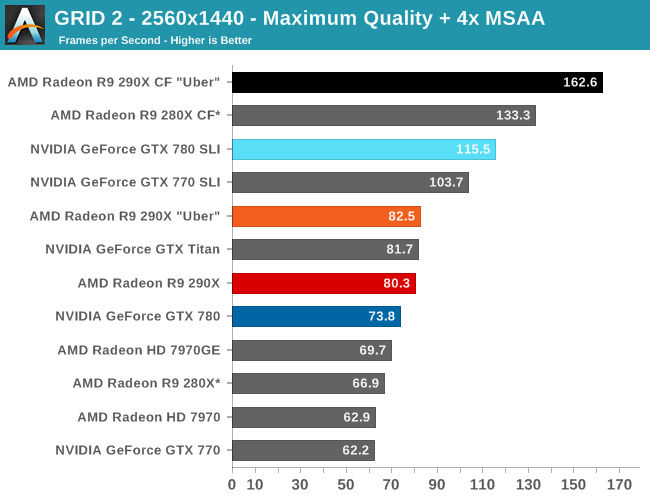
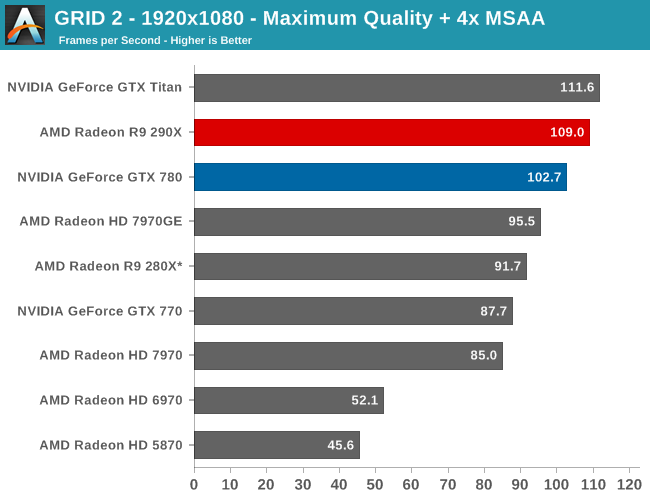
For as good looking as GRID 2 is, it continues to surprise us just how easy it is to run with everything cranked up, even the DirectCompute lighting system and MSAA (Forward Rendering for the win!). At 2560 the 290X has the performance advantage by 9%, but we are getting somewhat academic since it’s 80fps versus 74fps, placing both well above 60fps. Though 120Hz gamers may still find the gap of interest.
Moving up to 4K, we can still keep everything turned up including the MSAA, while pulling off respectable single-GPU framerates and great multi-GPU framerates. To no surprise at this point, the 290X further extends its lead at 4K to 21%, but as usually is the case you really want two GPUs here to get the best framerates. In which case the 290X CF is the runaway winner, achieving a scaling factor of 96% at 4K versus NVIDIA’s 47%, and 97% versus 57% at 2560. This means the GTX 780 SLI is going to fall just short of 60fps once more at 4K, leaving the 290X CF alone at 99fps.
Unfortunately for AMD their drivers coupled with GRID 2 currently blows a gasket when trying to use 4K @ 60Hz, as GRID 2 immediately crashes when trying to load with 4K/Eyefinity enabled. We can still test at 30Hz, but those stellar 4K framerates aren’t going to be usable for gaming until AMD and Codemasters get that bug sorted out.
Finally, it’s interesting to note that for the 290X this is the game where it gains the least on the 280X. The 290X performance advantage here is just 20%, 5% lower than any other game and 10% lower than the average. The framerates at 2560 are high enough that this isn’t quite as important as in other games, but it does show that the 290X isn’t always going to maintain that 30% lead over its predecessor.
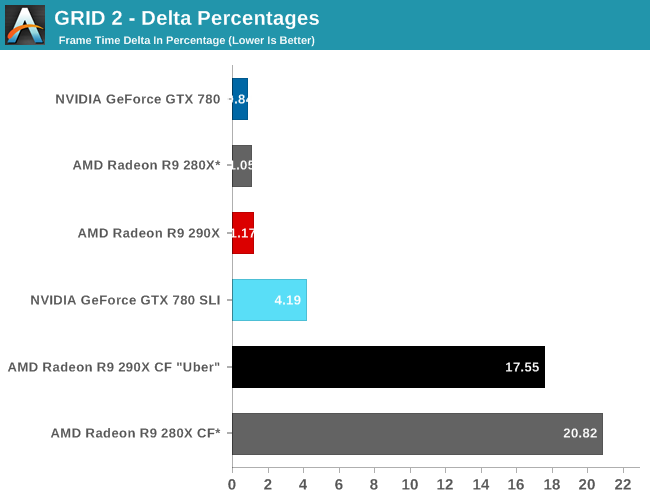
Without any capturable 4K FCAT frametimes, we’re left with the delta percentages at 2560, which more so than any other game are simply not in AMD’s favor. The GTX 780 SLI is extremely consistent here, to the point of being almost absurdly so for a multi-GPU setup. 4% is the kind of variance we expect to find with a single-GPU setup, not something incorporating multiple GPUs. AMD on the other hand, though improving over the 280X by a few percent, is merely adequate at 17%. The low frame times will further reduce the real world impact of the difference between the GTX 780 SLI and 290X CF here, but this is another game AMD could stand some improvements, even if it costs AMD some of the 290X’s very strong CF scaling factor.


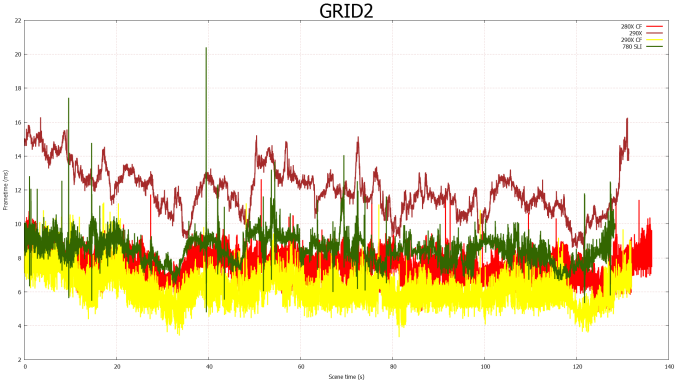








396 Comments
View All Comments
mr_tawan - Tuesday, November 5, 2013 - link
AMD card may suffer from loud cooler. Let's just hope that the OEM versions would be shipped with quieter coolers.1Angelreloaded - Monday, November 11, 2013 - link
I have to be Honest here, it is beast, in fact the only thing in my mind holding this back is lack of feature sets compared to NVidia, namely PhysX, to me this is a bit of a deal breaker compared for 150$ more the 780 Ti gives me that with lower TDP/and sound profile, as we are only able to so much pull from 1 120W breaker without tripping it and modification for some people is a deal breaker due to wear they live and all. Honestly What I really need to see from a site is 4k gaming at max, 1600p/1200p/1080p benchmarks with single cards as well as SLI/Crossfire to see how they scale against each other. To be clear as well a benchmark using Skyrim Modded to the gills in texture resolutions as well to fully see how the VRAM might effect the cards in future games from this next Gen era, where the Consoles can manage a higher texture resolution natively now, and ultimately this will affect PC performance when the standard was 1-2k texture resolutions now becomes double to 4k or even in a select few up to 8k depth. With a native 64 bit architecture as well you will be able to draw more system RAM into the equation where Skyrim can use a max of 3.5 before it dies with Maxwell coming out and a shared memory pool with a single core microprocessor on the die itself with Gsync for smoothness we might see an over engineered GPU card capable of much much more than we thought, ATI as well has their own ideas which will progress, I have a large feeling Hawaii is actually a reject of sorts because they have to compete with Maxwell and engineer more into the cards themselves.marceloviana - Monday, November 25, 2013 - link
I Just wondering why does this card came with 32Gb gddr5 and see only 4Gb. The PCB show 16 Elpida EDW2032BBBG (2G each). This amount of memory will help a lot in large scenes wit Vray-RT.Mat3 - Thursday, March 13, 2014 - link
I don't get it. It's supposed to have 11 compute units per shader engine, making 44 on the entire chip. But the 2nd picture says each shader engine can only have up to 9 compute units....?Mat3 - Thursday, March 13, 2014 - link
2nd picture on page three I mean.sanaris - Monday, April 14, 2014 - link
Who cares? This card was never meant to compute something.It supposed to be "cheap but decent".
Initially they made this ridiculous price, but now it is around 200-350 at ebay.
For $200 it worth its price, because it can be used only to play games.
Who wants to play games at medium quality (not the future ones), may prefer it.